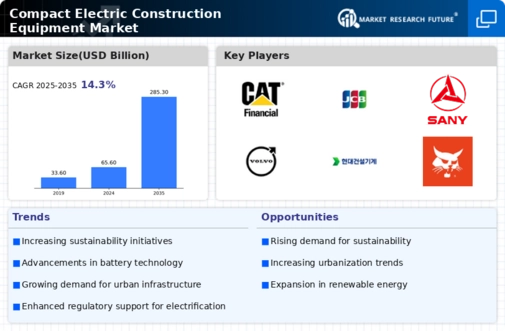Market Analysis
In-depth Analysis of Compact Electric Construction Equipment Market Industry Landscape
The Compact Electric Construction Equipment Market is currently experiencing dynamic shifts driven by a confluence of factors, including environmental concerns, technological advancements, and a growing emphasis on efficiency and sustainability in the construction industry. The demand for compact electric construction equipment, which includes electric excavators, loaders, and compactors, is on the rise due to the industry's increased focus on reducing carbon emissions and noise pollution. One key driver shaping market dynamics is the growing awareness of environmental sustainability. Governments and construction companies worldwide are increasingly recognizing the importance of transitioning to cleaner and greener construction practices. The compact electric construction equipment market is responding to this demand by offering eco-friendly alternatives that not only reduce the carbon footprint but also provide operational benefits such as lower maintenance costs and quieter operation on construction sites.
Technological advancements are playing a pivotal role in shaping the market dynamics of compact electric construction equipment. The development of advanced battery technologies, such as lithium-ion batteries, has significantly improved the performance and efficiency of electric construction machinery. Longer battery life, faster charging times, and increased power output have enhanced the viability of compact electric equipment for a wider range of construction applications. As the technology continues to evolve, manufacturers are investing in research and development to stay at the forefront of innovation, contributing to the dynamic nature of the market.
The competitive landscape is another factor influencing market dynamics. Major construction equipment manufacturers are investing in the development of compact electric models to expand their product portfolios and cater to the growing demand for sustainable construction solutions. The ability to provide high-performance electric equipment that meets or exceeds the capabilities of traditional diesel-powered machinery becomes a significant competitive advantage. Strategic collaborations and partnerships between equipment manufacturers and technology providers further contribute to the competitiveness of the compact electric construction equipment market.
Regulatory influences also shape the market dynamics of compact electric construction equipment. Governments around the world are implementing stricter emissions standards and promoting eco-friendly construction practices. Incentives and subsidies for the adoption of electric construction equipment are becoming common, driving the market towards sustainable solutions. Compliance with environmental regulations and the ability to meet or exceed emission standards are crucial factors for manufacturers in the competitive landscape.
Moreover, economic conditions and cost considerations play a role in market dynamics. While electric construction equipment may have higher upfront costs compared to traditional diesel-powered machinery, the total cost of ownership over the equipment's lifespan, including fuel and maintenance savings, is a significant consideration for construction companies. Economic factors influencing construction activity, such as infrastructure development projects and government spending, impact the overall demand for compact electric construction equipment.
Consumer preferences within the construction industry contribute to the market dynamics of compact electric construction equipment. Construction companies increasingly value the benefits of electric machinery, including lower noise levels, reduced environmental impact, and compliance with sustainability goals. As awareness grows and the benefits become more apparent, there is a shift in preferences toward electric alternatives, influencing purchasing decisions and driving the market dynamics.
Global trends, such as the rise of smart cities and sustainable infrastructure, impact the market dynamics of compact electric construction equipment. As urbanization accelerates, there is a growing need for construction equipment that aligns with the goals of creating more sustainable and environmentally friendly cities. Electric construction equipment, with its lower emissions and quieter operation, is well-suited to meet the requirements of modern urban development projects.










Leave a Comment